|
 Gliophorus luteoglutinosus Gliophorus luteoglutinosus
SynonymsHygrocybe luteoglutinosa
BiostatusPresent in region - Indigenous. Endemic
Images (click to enlarge)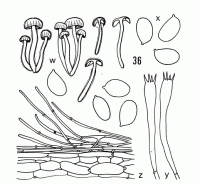
Caption: Gliophorus luteoglutinosus Hk. (type): w. carpophores. - x. spores. - y. basidia. - z. cuticle | 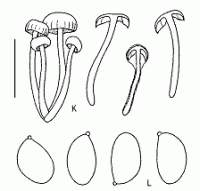
Caption: Fig. 33 Gliophorus luteoglutinosus Horak (K-L: PDD 27092, type):
K. basidiomes. L. spores. | 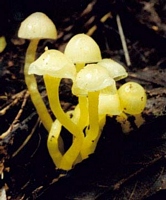
Caption: Gliophorus luteoglutinosus
Owner: Kaimai Bush | 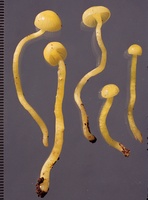
Caption: ZT71-086
Owner: E. Horak: © Creative Commons Attribution-Noncommercial 3.0 New Zealand | 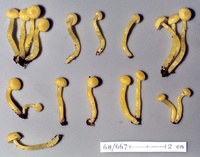
Caption: ZT68-667 , Holotype
Owner: E. Horak: © Creative Commons Attribution-Noncommercial 3.0 New Zealand | 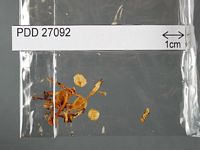
Caption: Dried type specimen
Owner: Herb PDD | 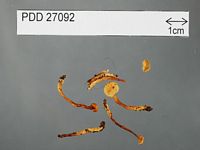
Caption: Dried type specimen
Owner: Herb PDD |
Article: Horak, E. (1990). Monograph of the New Zealand Hygrophoraceae (Agaricales). New Zealand Journal of Botany 28(3): 255-306 (http://www.rsnz.org/publish/abstracts.php).
Description: Pileus -12 mm, hemispherical, convex or plane, margin never upturned; lemon
yellow or sulphur yellow, fading with age; translucently striate at margin,
membranaceous. - Lamellae 6-8 (1-3) distant, adnexed to emarginate-adnexed,
not decurrent; whitish to pale yellow, edges entire, concolorous, glutinous
thread absent. - Stipe 13-30 x 1.5-3 mm, cylindrical, equal; concolorous with
pileus; glutinous, solid, flexuous, caespitose. - Context yellow, waxy. – Odour
and taste unpleasant, like burnt hair. - Chemical reactions on pileus: unknown.
Spores 7-9 x 5-5.5 um, ellipsoid. - Basidia 40-60 x -8 um, 4-spored. -Cystidia
absent -Pileipellis an ixocutis of repent to suberect cylindrical hyphae (1-4
um diam.), membranes strongly gelatinised, with plasmatic pigment; clamp connections
present (Pl. 1, Fig. 6).
Habitat: ECOLOGY: Scattered; saprobic on soil among litter in broadleaved-conifer forests.
June-July.
Distribution: DISTRIBUTION: NZ (NA, SA).
Article: Horak, E. (1973). Fungi Agaricini Novazelandiae I-V. Beihefte zur Nova Hedwigia 43: 200 p.
Description: Pileus 5-12 mm diam., hemispherical when young becoming convex, margin never upturned, lemon yellow or sulphur yellow, glutinous, translucidly striated at the membranaceous margin. Lamellae adnexed or emarginate adnexed, not decurrent, whitish to yellowish, gill edge concolorous, glutinous thread absent. Stipe 15-30 x 1.5-3 mm, cylindric,-concolorous with pileus, connected in dense clusters, glutinous, upper portion of stipe often dry, solid, flexuous. Context yellow. Odor and taste unpleasant, like burnt hair. Chemical reactions on pileus unknown.
Spores 7.5-9 x 5-5.5 µm, ellipsoid, smooth, inamyloid. Basidia 50-60 x 8 µm, 4-spored. Cheilocystidia absent. Cuticle consisting of repent or suberect, strongly gelatinized, hyaline hyphae (1-4 µm diam.) forming an ixocutis. Clamp connections present.
Habitat: In soil under Weinmannia, Metrosideros, Dacrydium. etc. New Zealand.
Notes: In moist and fresh condition the fruiting bodies of G. luteoglutinosus are covered with a thick layer of slime. This species is near G. chromolimoneus (Stev.) which lacks the pronounced and unpleasant odor and has conspicuous cheilocystidia forming a gelatinous thread on the gill edge. G. chromolimoneus Hk. is distinguished by its smaller spores and its occurrence in montane Nothofagus forests.
|